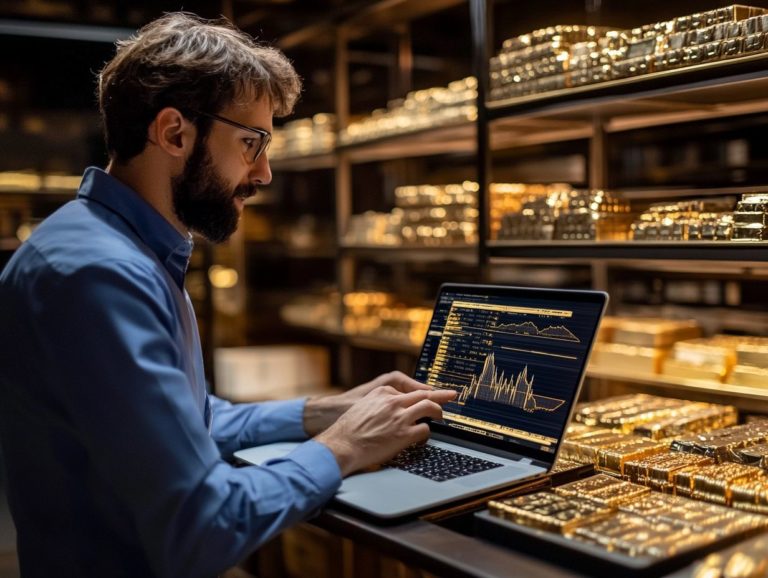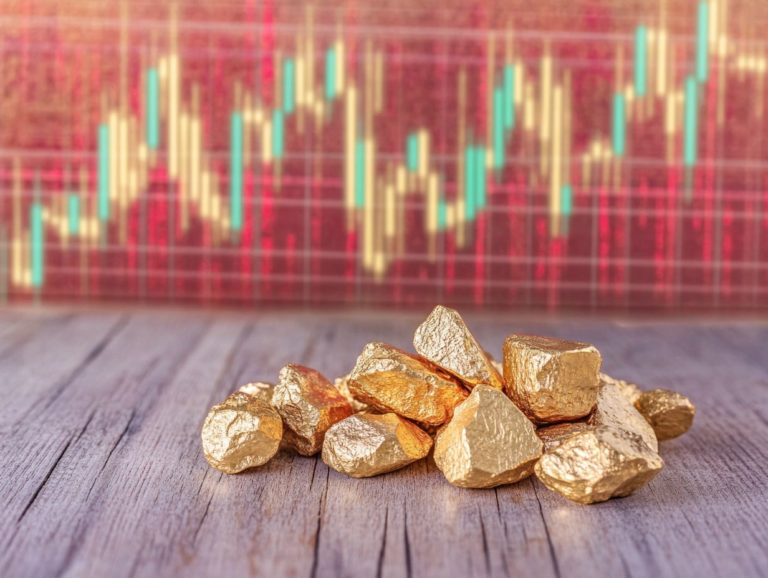5 Most Valuable Gold Coins Ever Sold
Gold coins have captivated collectors and investors for centuries, not merely for their intrinsic metal value but also for the rich histories and stories they carry.
This exploration delves into the five most valuable gold coins ever sold, featuring the iconic 1933 Double Eagle alongside the rare 1787 Gold Brasher Doubloon.
Discover what elevates the value of these coins, their historical significance, the factors influencing their worth, and how to authenticate them with confidence.
Embark on this captivating journey through the world of numismatic treasures!
Contents
- Key Takeaways:
- 1. 1933 Double Eagle – $7.59 Million
- 2. 1787 Brasher Doubloon – $9.36 Million
- 3. 1907 Saint-Gaudens Double Eagle – $7.59 Million
- 4. 1794 Flowing Hair Dollar – $10 Million
- 5. 1787 Gold Brasher Doubloon EB on Breast – $15 Million
- What Makes These Coins So Valuable?
- Frequently Asked Questions
- What are the 5 most valuable gold coins ever sold?
- What is the history behind the 1933 Double Eagle coin?
- Why is the 1787 Brasher Doubloon considered one of the most valuable gold coins?
- What makes the 1804 Class I Silver Dollar coin so valuable?
- Who designed the 1776 Continental Dollar coin and why is it valuable?
- What is the significance of the 1794 Flowing Hair Dollar coin?
Key Takeaways:
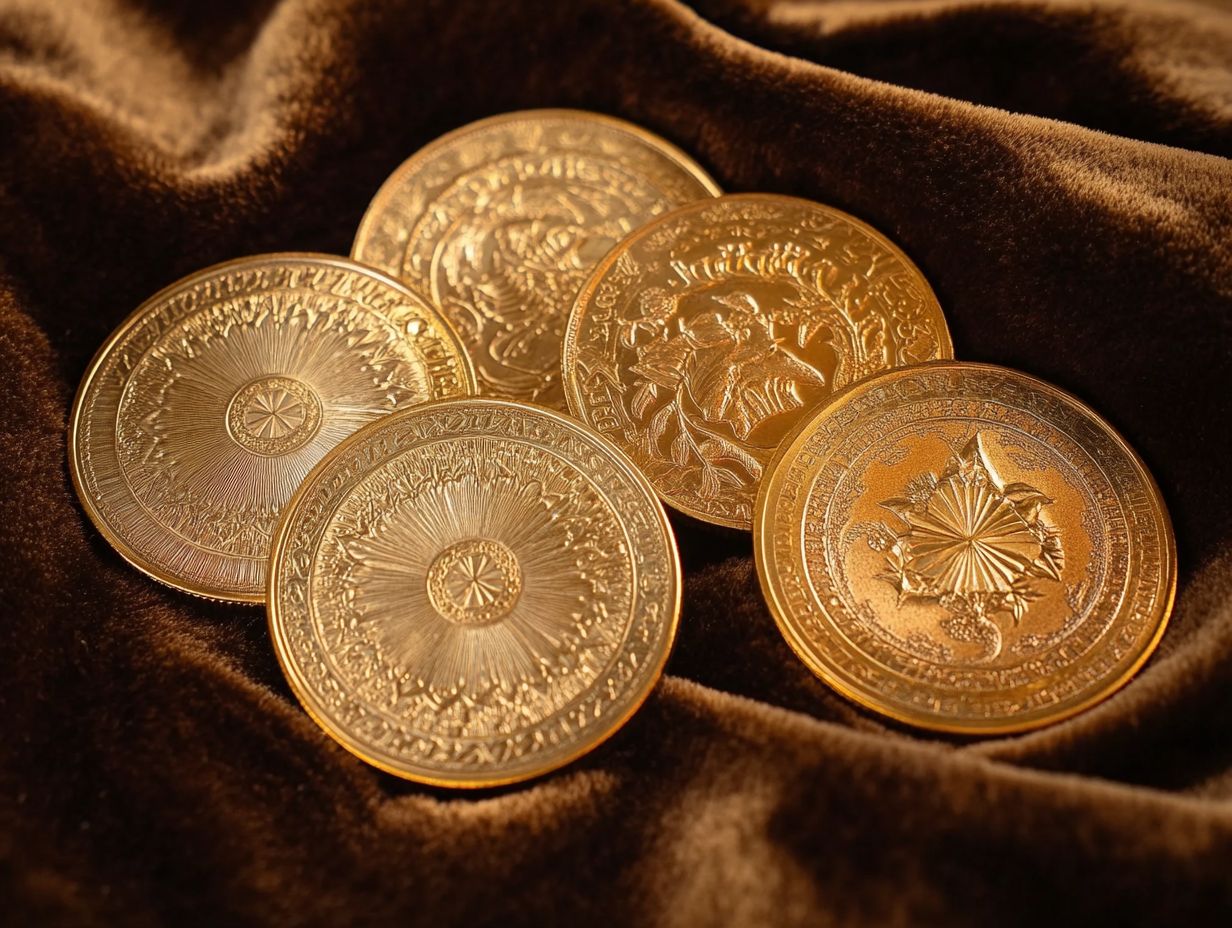
- The 1933 Double Eagle holds the record for the highest selling price of a gold coin at $7.59 million.
- The 1787 Brasher Doubloon is the second most valuable gold coin ever sold at $9.36 million.
- The 1787 Gold Brasher Doubloon EB on Breast holds the title of the most expensive gold coin ever sold at an astounding $15 million.
1. 1933 Double Eagle – $7.59 Million
The 1933 Double Eagle, an exquisite gold coin crafted by the U.S. Mint, has garnered an astonishing auction value of $7.59 million. This positions it as one of the most valuable coins worldwide. Its incredible value comes from its extreme rarity and rich history, particularly its connection to Franklin D. Roosevelt’s policies during the Great Depression.
Struck during a tumultuous time in American history, only a select few of these coins were minted before the gold standard was effectively abolished that same year. Most never graced circulation and were subsequently melted down, which only enhances the allure and mystique of the few that remain intact.
The Double Eagle boasts an intricate design featuring a majestic eagle alongside a depiction of Liberty. This showcases the artistry inherent in American coinage. As whispers about its existence spread, this coin transformed into a symbol not merely of wealth but also of the complicated relationship the United States has had with gold, currency, and economic stability.
Its record-setting auction price is not just a reflection of the coin’s rarity; it also signals a growing interest and investment potential within the coin collecting market that savvy collectors are eager to explore.
2. 1787 Brasher Doubloon – $9.36 Million
The 1787 Brasher Doubloon is a rare coin that beckons to collectors everywhere. It has fetched an astonishing auction price of $9.36 million. Its rich history and distinctive design by Ephraim Brasher secure it a prestigious spot in numerous museum collections.
This extraordinary piece of currency surfaced during a pivotal moment in American history when the nascent nation was establishing its monetary system. Ephraim Brasher, a skilled goldsmith in New York, played a crucial role in this evolution, crafting the coin as a symbol of the nation s emerging identity.
Its unique features intricate engravings and the captivating sunburst design add to its allure and historical importance. When seeking out this exceptional doubloon, you’re not just acquiring a remarkable artifact; you’re gaining a tangible connection to America’s past that resonates profoundly with coin enthusiasts around the globe.
3. 1907 Saint-Gaudens Double Eagle – $7.59 Million
The 1907 Saint-Gaudens Double Eagle, celebrated for its exquisite design and craftsmanship, has fetched an impressive $7.59 million, firmly establishing itself as a prized asset in the realms of coin collecting and investment. This coin is particularly cherished by coin collectors, who appreciate its artistic allure and rich historical context.
The design features an elegant portrayal of Lady Liberty, boldly striding forward, encapsulating a spirit of progress that resonates with the themes of the early 20th century. This imagery draws inspiration from the California Gold Rush, a transformative era that reshaped the American economy and deeply influenced its culture.
Its significance in American coinage is further enhanced by the innovative techniques employed by the artist, including intricate relief work and a masterful use of light and shadow. These elements amplify its rarity and desirability in today s coin market, where collectors actively seek pieces that embody both aesthetic beauty and compelling historical narratives.
4. 1794 Flowing Hair Dollar – $10 Million
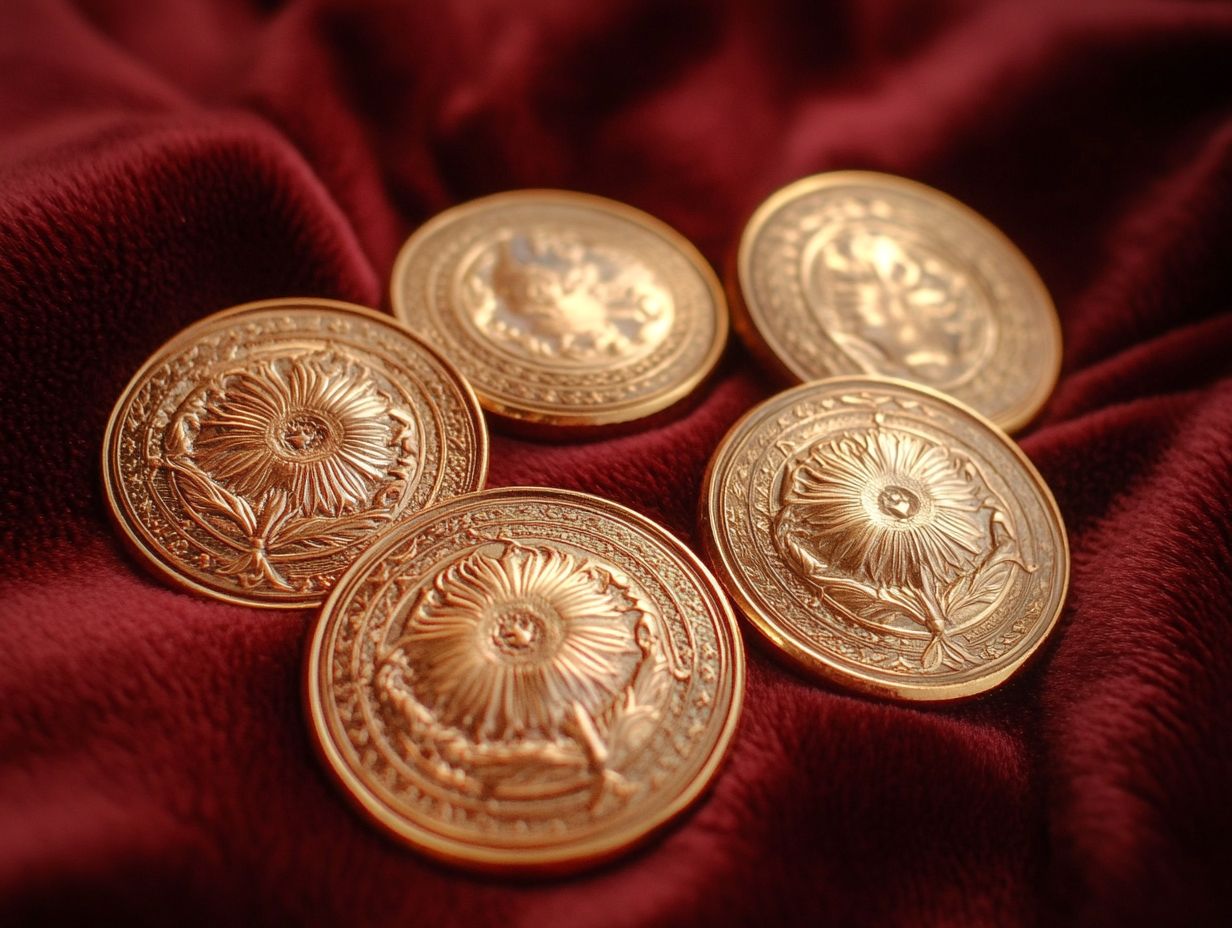
The 1794 Flowing Hair Dollar can sell for an amazing $10 million at auction. Its value comes from its rich history as the first coin produced by the U.S. Mint and its intricate design.
This remarkable coin features a liberty cap and swirling locks of hair, with an iconic eagle on the reverse. It offers a captivating glimpse into an era when the nation was still establishing its identity.
Collectors fiercely compete for this dollar, highlighting its rarity. Exhibits today showcase the Flowing Hair Dollar as not only currency but also as a vital cultural artifact.
5. 1787 Gold Brasher Doubloon EB on Breast – $15 Million
The 1787 Gold Brasher Doubloon EB on Breast recently sold for an extraordinary $15 million. This impressive price reflects its rarity and significant historical ties to the California gold rush.
This exquisite coin not only showcases intricate artistry but also symbolizes the profound economic changes of that time.
Its unique features include the engraved initials of its creator and bold imagery. This doubloon has garnered notable auction success, attracting collectors and historians alike.
Its presence in prominent collections marks it as a pivotal piece linking gold seekers to a broader story of American history.
What Makes These Coins So Valuable?
The value of certain coins, like the 1933 Double Eagle and the 1787 Brasher Doubloon, is shaped by rarity, historical significance, and demand among collectors. These factors make them excellent choices for your coin investment strategy.
As a collector, assess each coin’s provenance and condition. The rarity of a coin, especially if only a few were minted, greatly boosts its desirability and price.
The historical context of a coin can also enhance its appeal. Coins linked to noteworthy events or figures attract enthusiastic interest.
Condition, or grade, plays a crucial role in market value. Well-preserved examples fetch higher bids during auctions.
What Are the Historical Significance of These Coins?
Rare coins like the Edward III Gold and Augustus Saint-Gaudens pieces offer a glimpse into the political and economic landscapes of their times. They reflect societal values and key historical milestones.
These coins connect us to pivotal moments, such as the turbulent 14th century during Edward III’s reign. The intricate designs tell stories of national pride and craftsmanship.
Both coin sets embody their times, showcasing the cultural aspirations of their societies. Exploring these artifacts enriches your understanding of national identity and heritage.
What Factors Contribute to the Value of a Gold Coin?
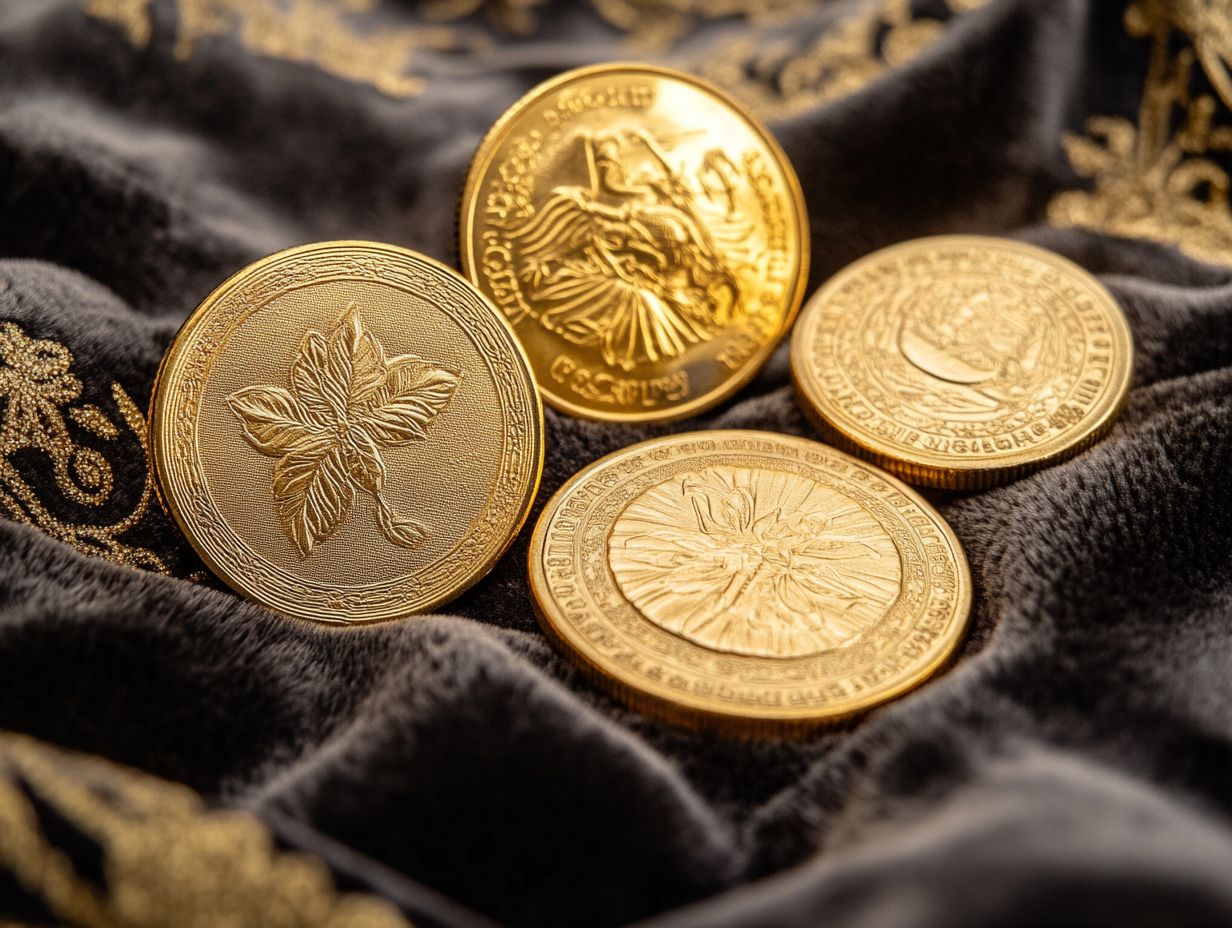
Several factors contribute to the value of a gold coin. Understanding them is essential for any discerning collector.
Rarity and historical context matter greatly. Demand among enthusiasts and recent auction results also play significant roles in shaping how people see the market.
The specifics of mintage numbers, meaning the number of coins made, are particularly crucial. Coins with lower mintages often command higher prices due to their scarcity.
Similarly, the historical significance attached to certain coins those minted during pivotal events or by renowned figures adds layers of intrigue and desirability.
The coin’s condition dramatically influences its valuation. Whether it s uncirculated, brilliant uncirculated, or shows signs of wear, each state carries its own implications for worth.
Monitor market trends, as fluctuations driven by economic conditions can sway collector interest and, ultimately, the perceived value of these precious artifacts. When collectors actively seek specific coins, it can lead to significant spikes in their market value. Timing and knowledge are essential to maximizing investment returns.
What Are the Most Expensive Coins Ever Sold?
The world of numismatics showcases some astonishingly expensive coins! Examples include the 1933 Double Eagle and the 1794 Flowing Hair Dollar.
When you see auction prices soaring to incredible heights, it s a testament to their rarity and the fervent demand among collectors.
These coins have incredible stories behind them. Take the 1933 Double Eagle, for example. It was never officially circulated due to the Great Depression, making its limited availability all the more intriguing.
Its price tags reflect that rarity, with a recent auction fetching over $7.5 million.
Then there’s the 1794 Flowing Hair Dollar, widely believed to be one of the first silver dollars struck by the U.S. Mint. It sold for over $10 million, underscoring its immense historical significance and value.
Market demands, rarity, and historical context all intertwine to shape these valuations. Collectors and investors alike seek pieces that offer more than just currency they are tangible links to our past.
What Are the Different Types of Gold Coins?
Gold coins come in various types, such as the Gold Saint-Gaudens, Half Eagle Gold, and Double Eagle. Each boasts unique features and historical significance that captivate both collectors and investors alike.
The Gold Saint-Gaudens is celebrated for its breathtaking artistic design. Minted in the early 20th century, it is often regarded as one of the most beautiful coins ever crafted.
The Half Eagle Gold, featuring a striking profile of Liberty, has origins rooted in the 19th century. It exemplifies both exquisite craftsmanship and the economic history of its time.
Then there s the Double Eagle, renowned for its larger size and intriguing design variations. This coin reflects an era rich with both prosperity and challenges.
This coin draws in collectors who appreciate not only the metal itself but also the captivating stories each coin tells. Each type presents distinct characteristics, from aesthetic allure to the narratives they encapsulate.
How Can One Determine the Authenticity of a Gold Coin?
Determining the authenticity of a gold coin is essential for you as both a collector and an investor. Counterfeit coins can lead to significant financial losses.
Understanding the key indicators of authenticity is vital for maintaining the integrity of your numismatic collection.
To verify authenticity, conduct detailed examinations of the coin’s physical characteristics. This includes its weight, diameter, and metal composition.
Mint marks, which indicate where a coin was produced, are crucial in establishing its legitimacy. Opting for professional grading services can provide you with independent evaluations that confirm a coin’s authenticity and condition, enabling you to make informed decisions.
In a market where gold coin values can fluctuate dramatically, grasping these verification methods safeguards your investments. They also elevate the overall trustworthiness of the collecting community.
Frequently Asked Questions
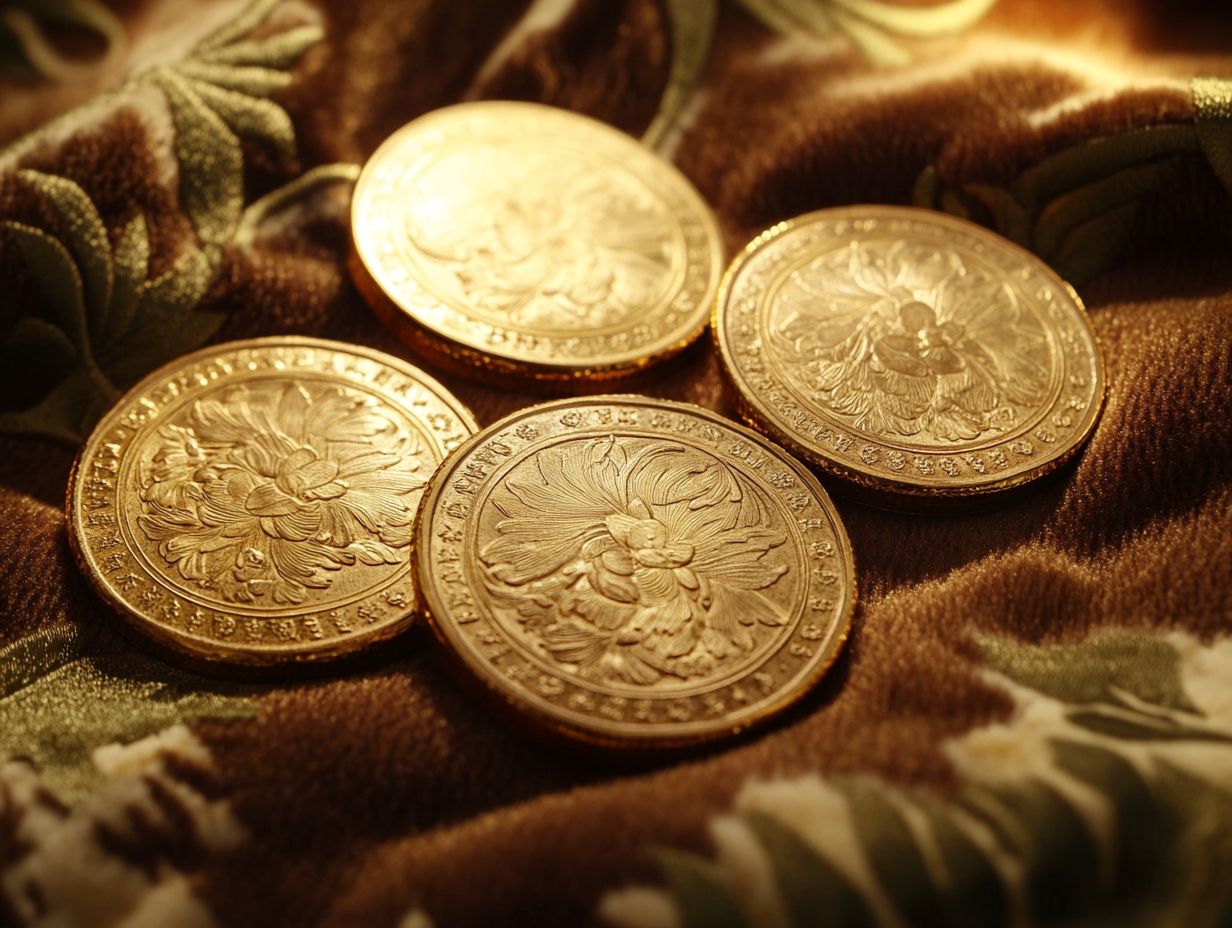
What are the 5 most valuable gold coins ever sold?
The five most valuable gold coins ever sold are:
- 1933 Double Eagle
- 1787 Brasher Doubloon
- 1804 Class I Silver Dollar
- 1776 Continental Dollar
- 1794 Flowing Hair Dollar
What is the history behind the 1933 Double Eagle coin?
The 1933 Double Eagle coin was made by the United States Mint. Most were melted in the 1930s when the gold standard changed.
Yet, a few coins escaped and later sold for record-breaking prices at auctions.
Why is the 1787 Brasher Doubloon considered one of the most valuable gold coins?
The 1787 Brasher Doubloon is highly valuable because of its rarity and important history. It was the first gold coin struck in the United States and was crafted by the famous goldsmith Ephraim Brasher.
What makes the 1804 Class I Silver Dollar coin so valuable?
The 1804 Class I Silver Dollar coin holds immense value due to its rarity and unique design. Only 15 of these coins were struck, primarily used as diplomatic gifts rather than circulated as legal tender.
This makes them a must-have for any serious collector!
Who designed the 1776 Continental Dollar coin and why is it valuable?
The 1776 Continental Dollar coin was designed by Benjamin Franklin. It was intended to be the first national currency of the United States but was never officially adopted.
This makes the few remaining coins highly sought after by collectors.
What is the significance of the 1794 Flowing Hair Dollar coin?
The 1794 Flowing Hair Dollar coin is notable for being the first silver dollar struck by the United States Mint. Designed by Robert Scot, it is prized for its rarity and historical importance as one of the earliest coins in American history.


